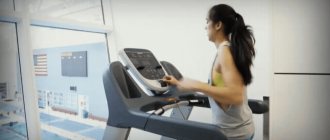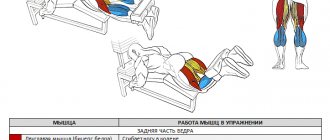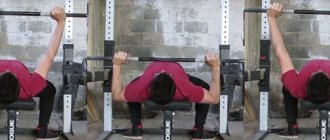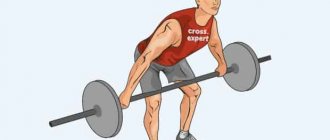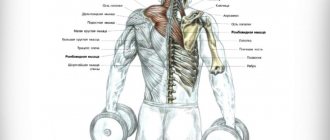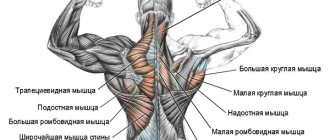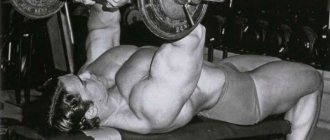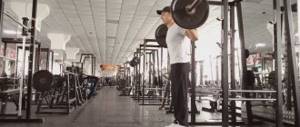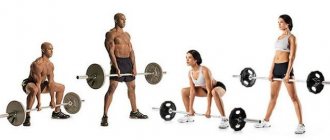September 11, 2021 Admin Home page » Training details
Learn how to do a shvung to increase your muscle strength and endurance. Execution technique, benefits of the exercise and analysis of the main mistakes.
In CrossFit, the push press is one of the most popular and sought-after exercises. After all, it develops the entire shoulder girdle well and gives explosive power. Just don’t confuse the shwung with the military press, which is done without pushing with the help of the legs, but the shvung is done with a push.
Benefits and features of the shvung exercise
Despite the fact that the main movement is performed by the muscles of the upper body, the lower part is also actively involved in shvungs. The fact is that when pushing the barbell over your head, your legs act as assistants during the push, due to which the projectile flies up using the force of inertia. Thus, during work, the hips, legs and buttocks also develop. The exercise develops explosive strength and increases endurance.
But there are also different types of shvungs, each of which has its own technical features and effect on the muscles. Let's take a closer look at each.
Execution technique
Initial position
- The barbell is installed on racks at a level just below the athlete's collarbones. It is important. The implement must not be placed too high so that the athlete has the opportunity to remove it correctly;
- The athlete takes a grip 10 cm wider than the edges of the bar, or 10 cm wider than his shoulders, if they are wide. The palms are placed symmetrically on the bar;
- Then you need to step under the bar strictly in the center and place it on the clavicle bones, grabbing it from below with your hands;
- The knees are bent; due to extension at the knee joint, the bar is removed from the racks;
- The athlete moves away from the racks, that’s it, he is ready to move as soon as he aligns his position and stabilizes his body
Movement
- The legs are slightly bent at the knees and sharply straightened;
- In proportion, the palms begin to move upward;
- The projectile overcomes the dead center by inertia;
- Elbows straighten;
- Hands press the projectile up and behind the head;
- The athlete fixes the barbell above his head;
- Then he bends his knees and returns the barbell to his chest.
Attention
- It is not allowed to throw the projectile behind the back as in a jerk;
- There is no need to stop at eye level and so that the bar is projected onto the top of the head;
- You should not knock the projectile away from your chest and drop it sharply on your collarbones;
- If possible, you should use a soft technique and do not insert your knees until they click;
- You should avoid sudden movements of your wrists and do not twist them at the top point of the trajectory;
- The hip joints extend in the same direction as the movement;
Shvung press with barbell
This type of exercise is performed through the movement of the arms and a slight squat, in which the legs, when straightening the knee joint, help push the barbell above the head.
What muscles work
- Anterior and middle bundles of deltoid muscles.
- Pectoralis major muscle.
- Triceps brachii muscles.
- Trapezius muscles.
Accessory muscles:
- Quadriceps femoris muscles.
- Biceps femoris muscles.
- Large gluteal muscles.
- Lumbar extensors.
- Calf muscles.
Barbell press technique
The barbell must be removed from the racks or lifted from the floor and taken onto the chest.
Initial position:
- The barbell is located on the front deltas, holding it with your palms with an underhand grip slightly wider than your shoulders.
- The elbows extend slightly forward and upward; the shoulder and forearms should not be strictly vertical.
- The hands with the barbell are in the kink of the joint.
- The feet are located slightly wider than the shoulders - neither narrow nor wide.
Performance:
- You need to sit down slightly, but do not squat until your thighs are parallel to the floor.
- Exhaling, straightening your knees from the squat with the strength of your legs, simultaneously push the barbell up, lifting it above your head with your elbows straight. The body and the bar above your head should be in the same plane.
- With this option, the feet should not leave the floor.
- As you inhale, you need to gently take the barbell onto your shoulders and at the same time sit down to avoid shock loads on your joints with your knees bent.
Common mistakes
- Let's look at the starting position in more detail. Most beginners perceive this exercise as a military press; accordingly, they keep their forearms perpendicular to the floor, which is strictly prohibited when doing pushups. The elbows should rise upward, throwing the barbell over the shoulders, which is also fixed with a kink of the hand. That is, the palms hold the barbell from below, arching the wrist.
- Podsed. You can often see too deep a dip or lack thereof, as when taking a barbell, which can easily injure the knee joints. Therefore, make sure that there is a slight dip both when pushing the barbell and when taking it onto your shoulders.
- Top position of the bar. When pushing out, you can also see a deflection in the lower back or thoracic region, in which the spine suffers and the center of gravity changes. In this case, you may not be able to resist and lose your balance. For some reason, many people place the barbell too far behind their head, which is absolutely not allowed. For the correct position, tense your abs and push the barbell strictly vertically, keeping your back straight.
Nuances and errors
When performing a push press with a barbell for the first time, it is important to avoid all mistakes in order to avoid them becoming ingrained in the mind, otherwise you will have to relearn everything:
♦ Before you begin, make sure your feet are slightly wider than your shoulders and your toes are slightly turned outward. Move the pelvis slightly back, the bar must lie on the front delts, and not be supported by weight with your hands;
♦ When performing a sit-up, make sure that your knees do not go forward; the same goes for your back. To do this, it is necessary that the weight presses on the heels, and the knees themselves move apart;
♦ If your knees move forward, your balance will be disrupted and it will be easy to fall backward under the weight of the barbell. In addition, the load on the knees and lower back will be excessive;
♦ Do not hunch your back during a squat; this can happen with too much weight. This overload shifts the barbell from the shoulders to the arms and not only reduces the efficiency of the exercise, but also increases its risk of injury;
♦ In order for the barbell to rest smoothly on your shoulders, you need to move them slightly forward, but your back should remain even with a slight arch;
♦ Many people think that the lower the squat, the easier it is to push the weight up, but this is a mistaken opinion. The strength of the push depends on the speed at which the legs are straightened, and the stronger the push, the lower the speed. Therefore, the squat is small, with a high speed of straightening the legs;
♦ When performing a squat, you must perform it smoothly; you should not fall down sharply or jerk, making unnecessary movements. With a sharp squat, the barbell slightly comes off the shoulders and, when lifting, sharply changes its upward direction, which complicates the final lifting of the barbell;
♦ The barbell is pressed completely onto straight arms using a squat; some, having finished the squat, press the last 5-10 cm. purely by arm strength, this is fundamentally wrong;
♦ It is necessary to lower yourself onto your heels after the push when the barbell is almost at the top with straightened arms;
♦ It is important to master the shock absorption of the legs, both when lifting and lowering the barbell. Heavy weights without balanced footwork will result in excessive stress on the lower back and knee joints.
Shvung push with a barbell
The name itself refers to the presence of a push, in which the feet lift off the floor and the bar flies up thanks to the explosive force and momentum created by the strength of the legs.
What muscles work
This technique works the same muscles as the push press. The only difference is that when pushing, the muscles of the legs work harder, or rather the shins, biceps and quadriceps of the thigh and buttocks.
Push push technique with a barbell
- Take the starting position described above ↑.
- Next, do a shallow squat and push up with your feet, lifting your heel off the floor while simultaneously pushing the barbell up above the top of your head.
- At the top point, the athlete’s position remains the same - strictly vertical.
- As you inhale, gently lower the barbell onto your deltoids, while sitting down so that your knees do not experience shock load. There is no need to tear off your feet here.
Typical mistakes in technology
- As with any other CrossFit exercise, athletes make mistakes in the push press. Let's look at them so we don't have to learn from our own.
- Squat too deep. In this case, our shungs turn into thrusters - also a good exercise, but not what we need now.
- In the starting position, many novice athletes hold the barbell with their hands, rather than resting on their deltoids (see picture above) (sometimes the problem is the flexibility of the body - some cannot twist their arms in the necessary way; in any case, you need to work on the correct technique).
- The athlete hunches his back during a squat. As a rule, this happens when working with already decent weights. An important signal: if you cannot perform an exercise with a large weight with proper technique, then switch to a lower weight and work until it works out perfectly.
- It is very important to take the barbell smoothly from the top position. It often happens that an athlete first “plops” it on his chest, and then does a squat for the next exercise. When lifting heavy weights, this can be hard on your joints—it's best to keep the downward movement from the top to the squat as one piece.
Overhead barbell push
This exercise is performed with a barbell positioned behind your head on the top of your trapezius muscle. The difference from the previous options is that the load and center of gravity shifts back, while the rear and middle bundles of the deltoid muscles, back and lower back muscles are activated, and the load on the triceps increases.
The overhead swing can also be a push and a press, the difference, respectively, is the lift-off of the feet with the push version, and the absence of lift-off with the press.
Overhead press press
Technique:
- Step up to the racks and place the barbell on the top of your trapezius muscle. Place your palms slightly wider than your shoulders, but not too far or too close to your shoulders.
- Remove the barbell from the racks and step back one step. Place your feet slightly wider than your hips for stability, but not too wide.
- Squat down slightly, not like in squats, and exhale while straightening your knees and push the barbell over your head, placing it strictly above the top of your head with straight elbows.
- As you inhale, gently accept the barbell onto your upper trapezius while sitting under the barbell again to protect your knees from shock and injury.
Load by muscle group
The load is indicated on a 10-point scale (the total load is summed up)
| Anterior delta | 9 (high) |
| Triceps | 7 (high) |
| Shin | 7 (high) |
| Front thigh | 6 (average) |
| Buttocks | 5 (average) |
| Middle delta | 4 (average) |
| Upper back | 3 (average) |
| Small of the back | 3 (average) |
| Posterior thigh | 2 (weak) |
| Total load/exercise type | 46 (high) / basic global |
| Load on the spine | 7 (high) |
Recommendations for training
- For beginners, it is important to perform shvung with minimal weight, or better yet, with an empty bar. A specialist must monitor the technique, otherwise you can make basic mistakes and learn the technique incorrectly.
- More advanced athletes should increase the working weight gradually, performing approximately 10 repetitions of 5-10 cycles. It is worth choosing a working weight within 60-70% of the maximum. Only after honing the technique can you increase the working weight.
- Girls should select a working weight for 10-20 repetitions and perform 5-10 cycles. The working weight should not be heavy. You should think of the exercise as a method of increasing endurance, not strength. In combination with other cardio and plyometric exercises, shvungs will help improve body contour and reduce adipose tissue.
Creating a program
Depending on the time allocation and goals of the athlete, sets of 1-6 repetitions can be performed.
4-6 reps will help with hypertrophy and help develop some strength.
Sets of 3-5 reps will most effectively develop strength and will help a little with hypertrophy.
1-2 repetitions per set are generally used to understand the athlete's maximum capabilities, but also develop strength characteristics.
Alternative Exercises
Program for progress in shvung
Below you will find recommendations on the percentage and number of sets of the push press within one workout. We take 8 workouts in total (at the rate of 1 workout with a push press per week - a total program for two months). Below are the numbers in % and the number of repetitions in parentheses.
- 50 (10 repetitions), 55, 60, 65, 70 – all 10 repetitions.
- 50 (10 repetitions), 60,65,75,80,75 (all 8).
- 50 (10 repetitions), 60,70,80, 85,82 (all 6).
- 50 (10 repetitions), 65 (6), 75, 82, 90, 85 (all 5).
- 50 (10 repetitions), 65 (6), 75, 85,91, 88 (all 4).
- 50 (10 repetitions), 64 (6), 75, 85, 95.91 (all 3).
- 50 (10 repetitions), 64 (6), 80 (5), 88 (3), 97 (2), 94 (2).
- 50 (10 reps), 64 (6), 79 (5), 88 (3), 91 (1), 97 (1), 102 (1), 105 (1)
We hope you liked our material on the wonderful CrossFit exercise - the push press with a barbell. Share it with your friends. If you have any questions, please feel free to comment.
Source
What muscles work?
When performed technically correctly, the push press with a barbell works a whole group of muscles - from the legs to the shoulders. Let's go over which muscles work the most in this case, and which muscles this exercise is best suited for working?
Upper muscle groups
Let's first look at the upper muscles that work during the press press. As you can see from the diagram it is:
- Deltas (front and middle);
- Pectoral muscles;
- Triceps;
- Upper back.
The anterior delta and triceps do the most work - the main load in the exercise falls on them.
Lower muscle groups
Among the lower muscle groups involved in the work are the following:
- Front and back of the thigh;
- Buttocks;
- Caviar;
- Small of the back.
When accelerating the bar upward, as well as when taking it to the deltoids, almost all leg muscles actively work.
To summarize the question of which muscles work during the push press, the deltoids, triceps, front and back of the thigh, calves and buttocks receive the key load.
Execution options
- You can do a barbell push from behind your head ; this option is good for those people who have sufficient flexibility in the shoulder joint. In bodybuilding, it is generally accepted that such a shvung works more on the middle deltoid bundles. In weightlifting, movement is used to teach balance with weight;
- Push shwung . It differs in that there is no phase of pressing the projectile with hands; as soon as the bar reaches eye level, the athlete goes under the bar and pushes the weight upside down. This option is the most technically complex in fitness; bodybuilding and crossfit are almost never used

